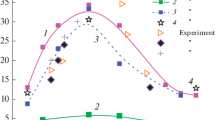Abstract
Results on the structure of the low‐temperature relaxation zone of the front of a laminar Bunsen flame of iso‐C5H12 (2‐methylbutane) under atmospheric pressure are presented. The flame of a premixed mixture iso‐C5H12 + O2 + Ar with a fuel‐to‐air equivalence ratio of 1.7 is examined. The mass fluxes, total rates of reactions of matter consumption and expenditure, balance of substances, and profiles of bulk heat‐release rates are calculated on the basis of the experimental concentration and temperature profiles. The results obtained indicate that there is a vast region of low‐temperature conversion of isopentane in the flame front. It is found that only part of the products sampled by the microprobe from different points of the flame front results from transformations in the low‐temperature region, namely, oxygen, isopentane, water, carbon monoxide, propane, methane, and methanol. Ethylene, propylene, hydrogen dioxide, and formaldehyde are present in the low‐temperature zone in insignificant amounts; they are secondary products of conversion of methyl and propyl radicals. It is assumed that the observed feature is a result of the competing interaction of two mechanisms of fuel‐mixture conversion: self‐catalysis and thermal self‐acceleration. Based on the previously suggested mechanism of oxidation pyrolysis by the scheme of intramolecular quadratic destruction, experimentally observed fragmentation of the isopentane molecule is demonstrated. In contrast to n‐pentane, formation of methyl alcohol has been found in isopentane convection products.
Similar content being viewed by others
REFERENCES
A. S. Sokolik, Self-Ignition, Flame, and Detonation in Gases [in Russian], Izd. Akad. Nauk SSSR, Moscow (1960).
G. I. Ksandopulo, Flame Chemistry [in Russian], Khimiya, Moscow (1980).
G. I. Ksandopulo and V. V. Dubinin, Chemistry of Gas-Phase Combustion [in Russian], Khimiya, Moscow (1987).
G. I. Ksandopulo, B. Ya. Kolesnikov, and D. S. Odnorog, “Low-temperature zone of the front of hydrocarbon ames. I. Oxidation of propane near the front of a ame,” Combust. Expl. Shock Waves, 10, No. 6, 757–761 (1974).
G. I. Ksandopulo, B. Ya. Kolesnikov, and D. S. Odnorog, “Low-temperature zone of the front of hydrocarbon ames. II. Oxidation of propane near the ame front in the presence of C2F4Br2,” Combust. Expl. Shock Waves, 11, No. 1, 52–57 (1975).
G. I. Ksandopulo, B. Ya. Kolesnikov, D. S. Odnorog, and V. V. Dubinin, “Low-temperature zone in a hydrocarbon-ame front. Part 4. Energy aspect of the oxidation of propane near a flame front,” Combust. Expl. Shock Waves, 11, No. 3, 350–354 (1975).
G. I. Ksandopulo, B. Ya. Kolesnikov, V. V. Dubinin, and D. S. Odnorog, “Low-temperature zone of the front of hydrocarbon ames. VI. Oxidation of hexane near ame front,” Combust. Expl. Shock Waves, 13, No. 4, 547–549 (1977).
G. I. Ksandopulo and R. A. Zubtsova, “Low-temperature zone in a hydrocarbon ame front. Part 9. Concentration profiles for peroxides in a hexane ame front,” Combust. Expl. Shock Waves, 19, No. 1, 17–19 (1983).
G. I. Ksandopulo, A. A. Sagindykov, S. E. Ku-daibergenov, and Z. A. Mansurov, “Low-temperature zone of the front of hydrocarbon ames. V. Profiles of the concentrations of atomic hydrogen and peroxide rad-icals at the front of propane–air ames,” Combust. Expl. Shock Waves, 11, No. 6, 714–718 (1975).
G. I. Ksandopulo, B. Ya. Kolesnikov, and D. S. Odnorog, “Concentration profile of atomic hydrogen in the low-temperature zone of the propane– air ame front,” Dokl. Akad. Nauk SSSR, 216, No. 5, 1098–1101 (1974).
G. I. Ksandopulo, A. A. Konnov, and I. V. D'yakov, “In-vestigation of the structure of gas-phase Bunsen ames by the method of laser-induced uorescence of the dis-tribution of OH radicals in the cold zone of the propane ame,” Khim. Fiz., 11, No. 8, 1180–1187 (1992).
E. Ranzi, P. Gaffuri, T. Faravelli, and P. Dagant, “A wide-rand modeling study of n-heptane oxidation,” Combust. Flame, 103, 91–107 (1995).
J. W. Bozzelly and W. I. Pitz, “The reaction of hydroperoxyl–propyl radicals with molecular oxygen,” in: Proc. 25th Symp. (Int.) on Combustion, Pittsburgh (1994).
N. Blin-Simiand, F. Jorand, K. Sahethian, et al., “Hydr-operaxides with zero, one, two or more carbonyl groups formed during the oxidation of n-dodecane,” Combust. Flame, 126, 1524–1533 (2001).
P. A. Glande, F. Battin-Leders, R. Fournet, et al., “Con-struction and simplification of a model for the oxidation of alkanes,” Combust. Flame, 122, 45–463 (2000).
G. I. Ksandopulo, “Macrokinetics and physics of staged ames,” in: Combustion and Plasma Chemistry, Proc. 1st Int. Symp., Inst. Problems in Combustion, Almaty (2001), p. 16.
H. S. Curran, P. Gaffuri, W. I. Pitz, and C. K. West-bvook, “A comprehensive modeling study of iso-octane oxidation,” Combust. Flame, 129, 253–280 (2002).
V. V. Dubinin, B. Ya. kolesnikov, and G. I. Ksandopulo, “Correctness of probe withdrawal of samples in ames,” Combust. Expl. Shock Waves, 13, No. 6, 785–788 (1977).
Author information
Authors and Affiliations
Rights and permissions
About this article
Cite this article
Ksandopulo, G.I., Kopylova, L.I. Chemistry of Combustion Waves in Substances with a Complicated Structure of Reagent Molecules. 1. Structure of the Front of Rich Isopentane Flame. Combustion, Explosion, and Shock Waves 40, 535–544 (2004). https://doi.org/10.1023/B:CESW.0000041405.24337.da
Issue Date:
DOI: https://doi.org/10.1023/B:CESW.0000041405.24337.da



